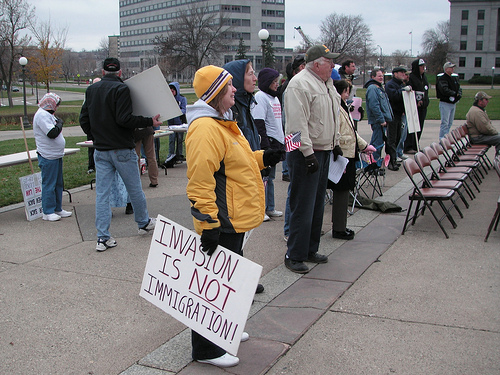
On Wednesday, we finally learned that two Democratic members of Congress from California will keep their jobs.
This was remarkable for two reasons.
First, Democrats in Congress got some good news for maybe the first time all year. And, secondly, these two victories mean that a Democratic incumbent in California hasn’t lost a House seat in 20 years.
Hmm. I wonder what happened in 1994 in California that suddenly changed the fortunes of Republicans.
*waves fingers in a dreamlike motion*
It was called Prop 187. Governor Pete Wilson rode this contentious ballot measure to ban undocumented immigrants from all public services to an easy re-election.
Ronald Reagan won his home state twice. George H.W. Bush won the state easily in 1988. And Wilson was the second two-term Republican governor in a row. But California was in the midst of a demographic transformation that hints at what the rest of what the nation will undergo for the next century.
By appealing narrowly to the fears of a dissipating white majority, the party won in 1994. And they continued winning over the next few years with a series of ballot measures that targeted the state’s undocumented population.
Then came the Prop 187 effect. “Not only did more Latinos start voting, they started voting heavily against the Republican Party,” Latino Decisions’ Matt Barreto explains.
The change wasn’t immediate. The biggest box office star in the world — who was married to a Kennedy — ran for governor in a wacky Darrell Issa-financed recall. Arnold’s two terms led the state into monstrous debt that has since been largely righted by a two-term Democratic governor.
And even in the biggest Republican congressional landslide since 1928, the GOP couldn’t oust a single Democrat in the Golden State.
California isn’t America. The state has liberal traditions and liberal-leaning industries that just don’t exist in, say, Texas. But the California experience could foreshadow a shift that could reshape American politics, especially because this shift is already occurring.
Mitt Romney earned less of the Latino vote than John McCain who earned less than George W. Bush.
The GOP knows that immigration reform won’t settle its problems with Latinos but it could offer a new opportunity to make their case. We know this because they said it after the 2012 election. Then came 2014 when Republicans could win and easily won by alienating Latinos in an aggressive way. The House GOP’s obvious disinterest in voting on the bipartisan reform bill that passed the Senate was driven by a majority that comes from 95 percent majority white districts. It was so obvious that activists gave up trying to pressure them to focus all of their efforts on compelling the president to take executive action to delay deportations of law-abiding undocumented immigrants with roots in the country.
The GOP’s strategy is multilayered. First of all, House Republicans will not allow this president to have any legislative victories. By slightly indulging in reform and then pulling out, presidential candidates — like Marco Rubio — make the argument that the only way to get reform is to put a Republican in the White House.
But the fact is the GOP can’t pass immigration reform. While most of the country is willing to offer citizenship to the undocumented — especially if they are forced to pay a fine and back taxes — 57 percent of Republicans prefer deportation.
For national Republicans now, like Pete Wilson in 1994, virulent anti-immigrant policies are winning policies. If the party can keep up their success with older white voters who lack a college education at this rate, it could win the White House in 2016. That would give them a chance to pack the Supreme Court with Justices with extremely narrow visions of undocumented rights.
But it wouldn’t change demographics.
Deaths of white Americans now outnumber births. The majority of students in America are now minorities. By the middle of this century, white people will not be the majority anything, except owners of golf pants. Most incredibly, more than 80 percent of the population growth of America between 2005-2050 will be immigrants or the children of immigrants, which will make it hard to terrify people with scary images of brown people .
This is all no guarantee that increasingly progressive Democrats will win the White House until an even more liberal party rises to challenge them around the time the last Fox News viewer passes away at some point in the early 2030s.
“Ethnic identity is fluid—it shifts and changes with the circumstances of society,” Jamelle Bouie points out.
Like Irish and Italian immigrants before them, Latinos and Asians may increasingly identify with the grumpy white mainstream. Some assimilation is inevitable. Identifying with the white majority tends to remove barriers to success and/or the enjoyment of Country-Western Music.
Perhaps minorities will even find themselves welcomed into a party that hasn’t won a majority of the black vote since 1932, once President Rubio passes reform and manages to withstand a primary challenge.
Or Nevada, Colorado and Florida will become more like California followed by North Carolina, Georgia and Arizona. Then maybe Texas.
Will 2014 change everything for the GOP? Their reaction to the president’s executive action will tell us. If we get a shutdown, impeachment or pro-deportation nominee in 2016, we’ll have a good idea what the future will look like. It’s happening now in the most populated state in the union.
[Image by Fibonacci Blue via Flickr ]



